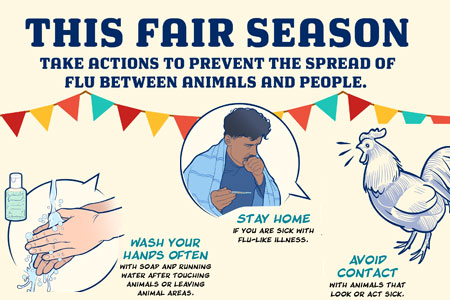
Let’s make clear at the outset that bird flu rarely affects humans. Even rarer is bird flu transmitted from an infected person to another human. Yet the potential remains for the virus to mutate, causing a devastating bird flu pandemic. Indeed, the virus has already jumped from birds to other animals, including dairy cows. As a resulted a few dairy workers have experienced a mild infection. With that in mind, the United States Centers for Disease Control and Prevention (CDC) recommends the following precautions to prevent the spread of bird flu at the county fair or poultry show.
Stay Home If You Feel Sick
If you have flu-like symptoms, stay home to avoid spreading illness to other people and to animals exhibited at the fair. Symptoms of bird flu are similar to symptoms of any other type of flu, although breathing problems are more common with bird flu. Other common bird flu symptoms in humans include fever, pink eye, upset stomach, vomiting, and diarrhea.
The same goes for poultry or other fair-going livestock that appear ill, or even if your flock has recently experienced any respiratory illness. Keep them at home to avoid unintentionally spreading bird flu at the county fair. Signs of bird flu in chickens may be as indistinct as ruffled feathers accompanied by lack of energy and appetite.
Eat Elsewhere
Don’t eat or drink while you are visiting barns or show arenas at the fair. That goes, too, for even touching your mouth or eyes.
Since flu spreads through breath, saliva, mucus, and stool, you can’t be sure if you might have touched something with flu virus on it. And flu viruses are more likely to be present in settings, like fairs and exhibitions, where humans and animals from various places come together in close contact.
Likewise, don’t bring anything into a livestock barn or exhibition area that your toddlers might put into their mouth or touch with their hands before putting their hands in their mouth. That includes any toys, pacifiers, drinking cups or bottles, strollers, and similar items.
Avoid Animals that Look Sick
Avoid direct physical contact with any animal that looks or acts ill, especially poultry, pigs, and cattle. Pigs and cattle, along with poultry, are especially vulnerable to bird flu.
What is direct physical contact? It includes touching, holding, and kissing an animal or being close enough for it to bite, lick, or scratch. If you absolutely have to come into contact with an animal that may be ill, wear personal protective equipment (PPE).
Disinfect Your Equipment
Clean and disinfect all your equipment — including feeders, waterers, travel carriers, and show supplies — before bringing them to the fair. Do not share equipment that has been used for other animals at the fair. And disinfect everything when you get back home.
Plus it’s always a good idea to quarantine returning birds for approximately four weeks before re-integrating them into your flock. The quarantine period gives you time to see if the birds have acquired any illnesses or diseases.
Wash Your Hands
We all know the mantra from the latest pandemic: Wash your hands often. Use soap and running water after touching poultry or other livestock, equipment associated with livestock, or leaving an animal area.
When soap and water are not available, use an alcohol-based hand sanitizer. You can make your own hand sanitizer for about one-quarter the cost of buying it.
Most of these commonsense suggestions pertain whether you exhibit at a fair or poultry show, or are tending your own flock at home. Don’t eat or drink while caring for your chickens. And thoroughly wash your hands after visiting your flock.
And that’s today’s news from the Cackle Coop.
Gail Damerow has written numerous books about keeping poultry, many of them available from the Cackle Bookstore. Illustration adapted from CDC Flu-Fair-Season-Poster.

